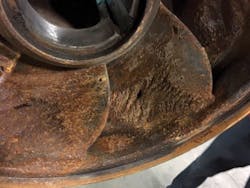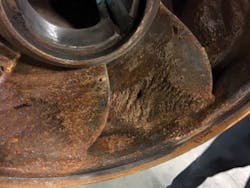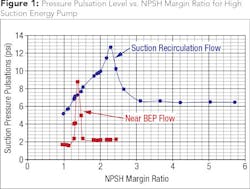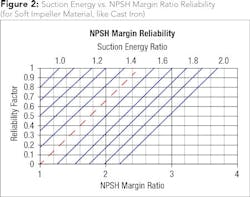High Suction Energy Pumps May Require Higher NPSH Margins Than Recommended
By Allan R. Budris
A field problem that I recently investigated further strengthens the Suction Energy/NPSH Margin methodology that I’ve developed over the course of my career and discussed in several past WaterWorld Pump Tips columns. This is by no means the first such field validation of this methodology, just the latest.
The current subject application involved six large, all-cast-iron, double-suction, split-case pumps on two large industrial cooling towers. High vibration and noise were noted from the start and after approximately nine months of operation the pumps started to fail. Upon disassembly and inspection, the inlet vanes were found to be badly pitted, eroded from cavitation and breaking through the vanes in places. The mechanical seals and bearings were also damaged, most likely caused by high vibration from the collapse of the cavitation bubbles.
Applying the Suction Energy methodology to this application showed the pumps to have high suction energy with an NPSH margin ratio of 1.36. Compare that to the methodology minimum recommended NPSH margin ratio of 1.5 to 2.0.
Further, the latest Hydraulic Institute standard on “Guidelines for NPSH Margin” recommends a minimum NPSH margin ratio of only 1.1 for cooling tower applications (1.2 for cast-iron wastewater applications). So, according to the latest Hydraulic Institute standard, this application should have had sufficient NPSH available.
Hydraulic Institute NPSH Margin Standard
This latest Hydraulic Institute standard (ANSI/HI 9.6.1-2012) provides a good general discussion on NPSH and NPSH margin, but the specific recommended NPSH margins (1.1 to 1.2 for this application) are on the low side, more applicable to low suction energy pumps. Further, instead of specifying higher NPSH margin values for high suction energy pumps, slightly higher values are specified for operation in the allowable operating flow region (AOR) vs. the preferred operating region (POR). The standard doesn’t, however, list cast iron for water applications, which could imply it is not recommended.
The standard does recognize that higher values of the key components of suction energy (Suction Specific Speed x Impeller Inlet Tip Speed) can impact pump reliability if sufficient NPSH margin is not provided. It states that: “High suction specific speed pumps, operating with high inlet tip speeds, are likely to be noisy with higher vibration and will possibly experience less than optimum pump life if sufficient NPSH margin is not provided.” However, no specific NPSH margin values are recommended for this condition.
It does go on to state that for inlet tip speeds above 100 ft/sec, the application should be reviewed for adequate NPSH margin. However, the problem field application in question has an impeller inlet tip speed of only 75 ft/sec.
A suction specific speed of over 13,000 is considered to be high, but the guideline only recommends reducing the AOR for this condition. Many industrial specifications limit the suction specific speed to 11,000. The suction specific speed for the problem field application is only 9,276.
Regarding the impeller material, the HI standard does state that cast iron and brass will undergo the most damage among commonly used metals, while stainless steel, titanium, and nickel aluminum bronze will exhibit much less damage under the same cavitation conditions. The problem application has cast iron impellers.
It further states that the recommended margin ratios can vary by pump type, vane overlap, and application, with higher values suggested for higher operating speeds, and/or continuous operation outside the POR of the pump.
It states that large pumps (with impeller inlets over 18 inches in diameter) can be more prone to problems from cavitation damage than smaller pumps. However, the pumps in the problem application have impeller inlets of only 14.5 inches.
The standard does caution that optimum pump performance requires proper intake/suction piping design be followed. The problem pump inlet piping does have unfilled bellows expansion joints attached directly to the pump suction flanges. This probably increases the amount, and possibly the severity, of the cavitation within the impeller, dictating an increase in the required NPSH margin by some unknown amount.
On the other hand, this HI standard cautions against specifying an excessive NPSH margin because it may result in a non-optimum pump selection, adding to the pumping equipment, station, and operating costs.
NPSH Margin Considerations
Pump net positive suction head required (NPSHR) does not represent the start of cavitation. It is actually the NPSHA (net positive suction head available) that will cause the total head to be reduced by 3 percent due to flow blockage from cavitation vapor in the entry of the impeller vanes. It can take from 1.05 to 2.5 times the NPSHR just to achieve the 100 percent head point, and typically 4 to 5 times the 3 percent NPSHR (or higher) to totally eliminate cavitation for flow rates above the start of suction recirculation. Figure 1 shows an example of how cavitation-caused suction pressure pulsations typically respond to varying NPSH margin ratio values for a high suction energy pump, both around the pump best efficiency point (BEP) and near the start of suction recirculation. Our field problem pump mainly operates at 80 percent of BEP, which is within the POR (typically 70 percent to 120 percent of the pump BEP).
Based on these facts alone, the HI/ANSI Standard NPSH Margin recommendation of 1.1 to 1.2 does seem low.
Suction Energy Method
Applying my suction energy methodology (see Pump Tips, Dec. 2012 and Jan. 2013) to this problem field application yields a suction energy ratio of 1.33 (well into high suction energy, where cavitation damage is possible, especially with soft impeller materials such as the cast iron used in our problem application) and an NPSH margin ratio of 1.36.
The most damaging liquid is noted to be water at about 100°F. The field problem pump is handling water at 85°F. I’ve found that high suction energy pumps handling water of this temperature typically require minimum NPSH margin ratios of 1.5 to 2.0 within the AOR. Based on the reliability graph developed for this method (see Fig. 2), this field problem yields a reliability of only 0.5 vs. a maximum of 1.0. This compares well to the actual impeller life of 9 months, especially with unfilled bellows expansion joints attached directly to the pump suction flanges.
Appendix B of the 2003 Hydraulic Institute Standard on Pump Piping (ANSI/HI 9.6.6-2003), which I chaired, also specifies a minimum NPSH margin of 1.5 for high suction energy cooling tower pumps.
Consider the Europump Maximum Speed Recommendation, included as part of the HI/ANSI 9.6.1 NPSH Margin Standard Appendix for informational purposes (but not considered a formal part of the standard). A Europump graph for water and wastewater pumps recommends a maximum pump speed of 1,000 RPM for a 15,000 gpm application with a NPSHA of 34 ft, like the field problem in question. However, this installation, which is generally acceptable to the HI/ANSI NPSH margin standard, actually uses pumps operating at 1,200 RPM. Analysis of two potential lower speed pump alternatives (1,030 RPM and 900 RPM) for this field application using the suction energy methodology both predicted maximum reliability.
In other words, for this high suction energy application, the Europump standard NPSHA/speed recommendation agrees with the suction energy methodology but not the specific recommendations from the main portion of the HI/ANSI NPSH margin standard.
Conclusion
The take-away message from this column should be this: High suction energy pumps may require higher NPSH margins than recommended by current industrial standards. This recent field problem reinforces the need to determine the suction energy and suction energy reliability for new pump installations as part of establishing the recommended NPSH margin ratio - and not blindly accepting the minimum recommended NPSH margins listed in the industry standard.
When a pump is determined to have high suction energy, a higher NPSH Margin than listed in the standard may very well be required if the pump suction energy cannot be lowered. At the very least, it should be provided with a superior impeller material or cavitation-resistant coating (see Pump Tips, April 2012), even if it results in a higher initial cost.
About the Author: Allan R. Budris, P.E., is an independent consulting engineer who specializes in training, failure analysis, troubleshooting, reliability, efficiency audits, and litigation support on pumps and pumping systems. He can be contacted via email at [email protected].



